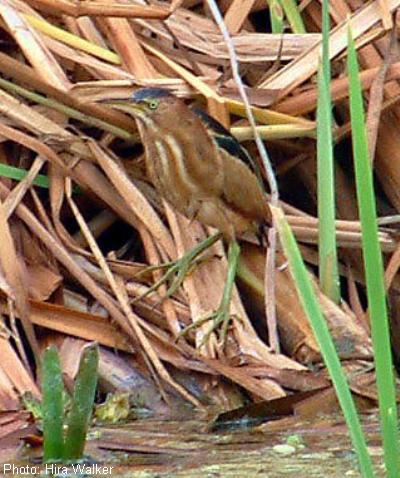Species Information
Kingdom: Animalia
Phylum: Craniata
Class: Aves
Order: Pelecaniformes
Family: Ardeidae
Genus: Botaurus
Species: exilis
Least Bittern - Botaurus exilis

Image courtesy of Biota Information System of New Mexico
328709
Species Extent (New Mexico)
General Description
In comparison to other herons, bitterns are more solitary and rely more heavily on auditory than visual communication. Bitterns also have a laterally compressed trunk, short legs, short outer toes, and long, curved toenails that enable them to travel through and grasp the dense, emergent vegetation typical of nesting habitats (Kushlan 1978, Hancock and Kushlan 1984). The smallest member of the heron family, the least bittern ranges between 28-36 cm in length, average 33 cm, and has a wingspan of 43 cm (Cramp 1977, NGS 1983). It has a straight, slender, pointed bill and a large buffy patch on the inner half of the upper side of each wing. The head is slightly crested. Whitish, highly visible lines border the scapular feathers. Sexes are similar in size, but plumage is dimorphic. The crown and back of the female is purple-chestnut, whereas those of the male are black, and the neck of the female is darkly streaked (Palmer 1962). Juvenal plumage is similar to that of the adult female, but the crown of the juvenile is paler and more brown, and the breast and throat are browner with heavier streaking. The only seasonal difference in plumage is a high gloss in spring (Weller 1961). A rare, darker morph occurs, known as "Cory's bittern," in which paler areas of typical plumage appear chestnut-colored (Palmer 1962, Hancock and Kushlan 1984). Young are covered with long, soft, ochre-colored down above and whiter down beneath (Palmer 1962, McVaugh 1975). Detailed descriptions and illustrations of the plumage development of young are provided by McVaugh (1975). <br /><br />NEST: Usually built over shallow water (0.1-1.0 m deep) (Palmer 1962, Kushlan 1973, Aniskowicz 1981) and tend to be near, less than ten meters from open water (Weller 1961). A nesting platform with a canopy is made by pulling down and crimping surrounding emergent vegetation, such as cattail or bulrush (Weller 1961). <br /><br />EGGS: Elliptical, pale blue or pale green, smooth and non-glossy, averaging 31 by 24 mm (Bent 1926, Harrison 1978). <br /><br />VOCALIZATIONS: Quite vocal with a varied repertoire of calls. The male's advertisement call most frequently heard in spring is a dove-like cooing characterized as "uh-uh-uh-uh-uh-oo-oo-oooo-oo-ooah" (Palmer 1962). Females may respond with "ticking" calls (Hancock and Kushlan 1984). When alarmed, three calls may be uttered: a loud, shrieking "quoh," a hissing "hah," or cackling "tut-tut-tut" (Palmer 1962, Hancock and Kushlan 1984).
Status
Observations in Natural Heritage New Mexico Database
Number of Subpopulations: 3
Number of Mapped Locations: 3
Number of Observations: 4
Observation date range: 01-01-1974 to 07-01-1987
External Links
View More Information about this species at:
Biota Information System of New Mexico (BISON-M)
NatureServe Explorer
Environmental Conservation Online System (ECOS)
New Mexico State Wildlife Action Plan (NMSWAP)
Biota Information System of New Mexico (BISON-M)
NatureServe Explorer
Environmental Conservation Online System (ECOS)
New Mexico State Wildlife Action Plan (NMSWAP)